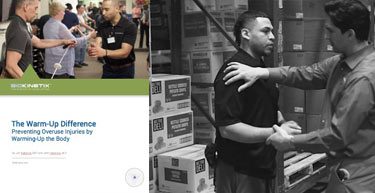Abstract:
In the context of sports medicine and athletics, the process of warming up with active muscle contraction has long been utilized as a way to successfully prepare the body for physical activity. Although many workplace health programs encourage stretching for injury prevention, there is little medical evidence to support the effectiveness of such a practice. However, the inherent benefits of warming up can and should be applied in an occupational setting to combat the detrimental effects of muscle overuse injuries.
The human body holds the extraordinary potential to protect itself from musculoskeletal disorders. Knowing how to warm up properly and avoid injury has been proven to be the most effective way to use this potential by preparing the body to handle repetitive and strenuous movements with resilience.
Sample:
Warming-Up to Prevent Overuse Injuries
Musculoskeletal injuries and disorders that result from muscle overuse are preventable by warming up, which can be performed quickly and easily before engaging in strenuous physical activity. In terms of musculoskeletal function, workers are no different from athletes. Just as athletes must warm up before engaging in rigorous physical activity, workers need to physically prepare themselves for performing stressful, repetitive tasks with warm-up exercise programs.
Why Not Stretch?
A growing body of research has revealed that the age-old mantra of “stretch, stretch, stretch” does not help prevent injuries or muscle soreness. Numerous studies show that those who stretch instead of warming up before an activity demonstrate a decrease in overall performance. Injuries, muscle overuse, and soreness also appeared more significant in people with a high level of flexibility who stretched before physical activity.
Comparing the act of stretching to a warm-up can best be understood in the context of muscle physiology. The muscles in the body are constantly working together to create limb movement; when one muscle group contracts, the opposite muscle group lengthens in response. Warming up reduces work-related injuries by activating these muscles through either lengthening (eccentric contractions) or shortening (concentric contractions) while generating force.
On the other hand, stretching lengthens the muscles while it remains in a passive state. However, it does not require muscle overuse. By increasing the range of motion in certain joints, stretching can cause unnecessary lengthening of tendons and can be dangerous when performed incorrectly.
Learning how to warm up properly and avoid injury can be accomplished only by performing active movements using external forces. Stretching, which calls for people to push and pull on their joints, is not dynamic in this sense and does not warm up the body. But how does warming up the body prevent injury?
Performing active movements with resistance will challenge the muscles and warm them up even more rapidly. Unlike stretching, warming up challenges the body to trigger all the built-in elements and mechanisms that will help prevent muscle overuse, RSIs, and MSDs. Because performing repetitively stressful movements throughout the day is physically taxing, warming up must become a consistent habit for people who regularly engage in these movements.
How Warming-Up Works?
Warming up prepares the body both physically and psychologically. Therefore, it is necessary for anyone who plans on engaging in physical activity. Not only does warming up help the body withstand the stresses of repetitive movements with better efficiency, but it also reduces the risk of suffering from RSIs or MSDs.
Knowing how to warm up properly and avoid injury is crucial. A proper warm-up consists of several steps, which should:
- Involve movements that are specific to the activity in which you are about to partake
- Use large muscles first, and then move into smaller groups to avoid muscle overuse
- Start with simple movements first, then move to more complex movements
- Start with muscle groups that you will use throughout the day, then move to opposite ones that you won’t use
Conclusion
Although significant regulatory measures have been implemented over the past several decades to address occupational injury causation, MSDs continue to impact the workforce at alarming rates. Sports science has also shown us that stretching and performing active movements without resistance fail to prepare individuals for repetitive stress. That is because they do not stimulate the body to ready itself for activity. Instead, workers must protect themselves from muscle overuse and MSDs by warming up, a proven act for properly preparing the body for the repetitive stress of daily physical tasks. Warming up helps reduce the risk of overuse injuries by readying the muscles, tendons, fascia, ligaments, and joints for the strenuous movements required to complete most job tasks. Learning how to warm up properly and avoid injury ultimately helps the body become more resilient and better equipped to handle repetitive stress.
If, in addition to mitigating workplace hazards through ergonomic evaluation, individual employees adopt the practice of warming up regularly, they can avoid the pain, discomfort, and loss of productivity caused by MSDs and muscle overuse. Furthermore, by encouraging employees to warm up, businesses can reduce the risk of workplace injuries. They can also avoid the loss of productivity and burdensome financial consequences that inevitably result from each case.




